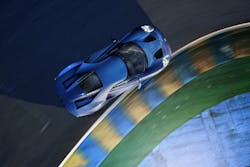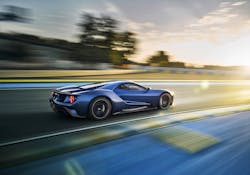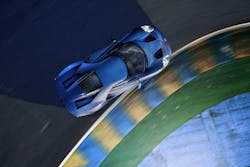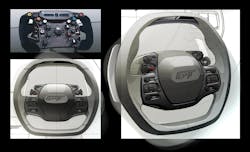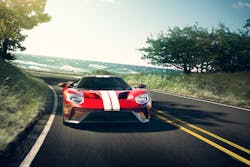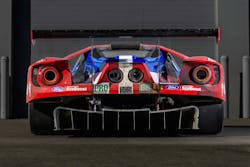Two years ago, the new Ford GT was a sleek and shiny concept car that consumers didn’t know would eventually reach production. Before that, 2005 through 2006, one of its namesakes was already a production car with about 4,000 made over two years. And before that, the original GT40 was a British-built Ford racing car that enjoyed significant success throughout the 1960s on several racetracks.
All of those versions of the GT differ in many ways, but the core concept—a two-seat, high-performance sports car—remains quite obvious in Ford’s most recent offering, a limited production GT with 1,000 to be built from 2017 through 2020. Those plans could change, however, as the company quickly sold out of the originally planned production run, even with a hefty price tag of $400,000.
Here’s a look at what Ford will show us of the new GT.
The 3,300-lb. GT is powered by a twin turbocharged and intercooled 3.5-liter V6 EcoBoost engine. The mid-mounted engine cranks out up 647 hp and 550 ft.-lb. of torque, enough to give the car a top speed of 216 mph and a 0 to 60 mph time of about 2.6 seconds. EPA rates it at about 14 mpg (combined city and highway).
The GT sports a rear wing that is an integral part of the car’s aerodynamic design. It automatically changes its shape to improve airflow when deployed. (Note: It is not deployed in the previous image). It can also be positioned to act as an airbrake to quickly slow the car when needed.
From the top, the “buttresses” arcing from the tops of the rear fender to the roof are visible, as are the spaces between the sides of the car and the buttresses. They strengthen the chassis, support the roof, and guide air flowing over the body to reduce drag and add downforce to improve handling and performance. You can also see the light weight, strong Gorilla Hybrid Glass from Corning used on the windshield and to cover the mid-mounted engine.
This nighttime photo shows the rectangular, stacked LED headlights and air inlets just forward of the rear wheels. The inlets funnel cool air to the intercoolers and to the engine’s intake. The car’s body panels are constructed of carbon fiber and supported by aluminum structural supports, both of which contribute to the car’s light weight.
The adjustable and telescoping steering wheel on the GT caries a wide array of controls and displays, including illuminated shift lights and shifting paddles to control the seven-speed, dual-clutch automatic transmission. The driver also has a 10-in. color LCD instrument cluster and a 6.5-in. touchscreen for infotainment and navigation. There’s also voice activation for the infotainment and navigation.
The rear-wheel-drive Ford Gt measures just 43.7 in. high and is almost 80-in. wide and 188 in. long. The driver can control the ride height, adjusting it by 50 mm to lower or raise the center of gravity and optimize handling. Carbon-ceramic brakes from Bembo supply most of the stopping power, with six-piston versions up front and four-piston versions on the rear.
The GT’s dual exhausts come through the midsection of the bodywork on the rear of the car, even on this racing version. This maximizes the performance of the diffuser and helps the airflow flow smoothly over the top of the body.
Ford had great success with its new GT even before this year: It won at Le Mans last year in the GT class, almost exactly 50 years after a trio of Ford GT40s placed first, second, and third in the 24-hour race. There were also three other New GTs in the race. They finished third, fourth, and ninth.
About the Author
Stephen Mraz Blog
Senior Editor
Steve serves as Senior Editor of Machine Design. He has 23 years of service and has a B.S. Biomedical Engineering from CWRU. Steve was a E-2C Hawkeye Naval Flight Officer in the U.S. Navy. He is currently responsible for areas such as aerospace, defense, and medical.
